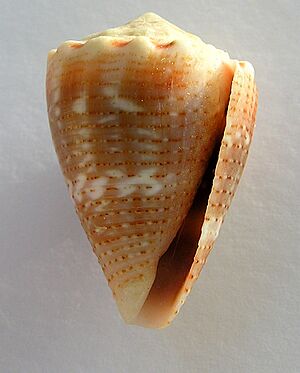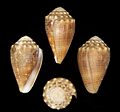Conus miliaris facts for kids
Quick facts for kids Conus miliaris |
|
|---|---|
 |
|
| A shell of Conus miliaris miliaris | |
| Conservation status | |
| Scientific classification |
The Conus miliaris, also known as the thousand-spot cone, is a type of sea snail. These amazing creatures are marine gastropod molluscs. They belong to the family Conidae, which includes all the different cone snails.
Like all cone snails, Conus miliaris is a predatory animal. This means it hunts other creatures for food. These snails are also venomous, so they can "sting" if they feel threatened. Because of their venom, it's very important to be careful around live cone snails. It's best not to touch them at all.
Contents
Types of Thousand-Spot Cone Snails
There are two main types, or subspecies, of Conus miliaris:
- Conus miliaris miliaris Hwass in Bruguière, 1792
- Conus miliaris pascuensis Rehder, H.A., 1980
What Does the Thousand-Spot Cone Look Like?
The shell of an adult Conus miliaris can be anywhere from about 12 mm to 43 mm long. That's roughly half an inch to one and a half inches!
Its spire (the pointed top part of the shell) can be tall or flatter. It might have lines or bumps, or sometimes it's quite smooth. The main part of the shell, called the body whorl, often has lines. These lines can feel bumpy, especially near the bottom.
The shell's color can be yellowish, light brown, or grayish. It often has darker brown or olive patches. You might also see irregular light bands around the middle and below the spire. Small brown spots often circle the shell along its lines. Inside, the shell is usually chocolate brown with a white band in the middle.
There's a lot of variety in how tall the spire is and how bumpy it is. The colors and patterns on the shell can also look quite different from one snail to another.
Where Do Thousand-Spot Cone Snails Live?
Conus miliaris is found in many places around the world. It's quite common in tropical and subtropical shallow waters.
You can find these snails in the Red Sea and along the eastern coast of Africa. This includes places like Aldabra, Chagos, Kenya, Madagascar, Mauritius, Mozambique, and Tanzania. They also live all the way to Easter Island and Sala y Gómez in the southeastern Pacific Ocean. However, they are not found near the Galapagos Islands, the Marquesas Islands, or Hawaii. In Australia, they live off the coasts of New South Wales, the Northern Territory, Queensland, and Western Australia.
How Does the Thousand-Spot Cone Eat?
As mentioned, these snails are predatory and venomous. They hunt for their food. Because they can sting humans, it's always safest to observe them without touching.
Scientists have noticed something interesting about Conus miliaris at Easter Island. There aren't many other cone snail species there. Because of this, Conus miliaris has a wider variety of prey at Easter Island. It's also more common there than in other places.
In most areas of the Indo-West Pacific, Conus miliaris lives alongside many other cone snail species (sometimes up to 36 different kinds!). In these places, it mostly eats three specific types of polychaete worms, which are a kind of marine worm.
But at Easter Island, its diet is much broader. It eats more kinds of these worms, including different types of eunicids, nereids, and onuphids. It also eats members of seven other worm families. Some of the worms it eats at Easter Island include Lysidice collaris, Nematonereis unicornis, Eunice afra, Eunice cariboea, Palola siciliensis, Perinereis singaporensis, and Onuphis species.
Gallery
Here are some pictures showing different colors and one subspecies of Conus miliaris:







